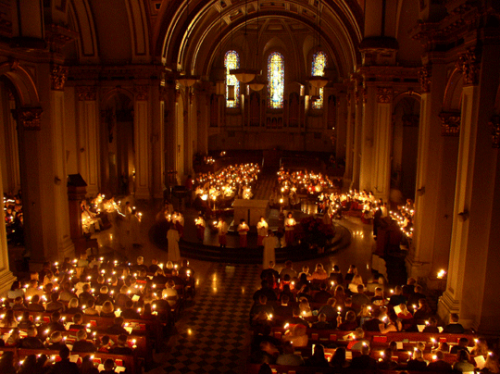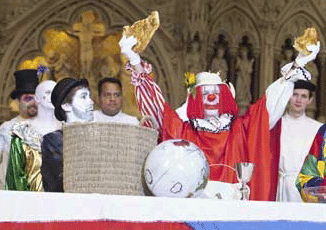 U.S. News & World Report's Jay Tolson has an interesting piece that looks at a return to traditionalism amongst Roman Catholics, Evangelicals, Jews and Muslims. Because the article attempts to cover so much important ground, it ends up being necessarily shallow. I think journalists and editors think they are being more respectful of major religions by including so many in stories such as this one, but they end up doing every religion a disservice through superficial treatment.
Still, this is a very important topic that could and should get a lot more coverage. Not the least of which is because there are different types of tradition, as Tolson uncovers. After discussing a Washington church's offering of Tridentine Mass, he looks at a non-denominational church in Texas that offers Holy Communion weekly:
U.S. News & World Report's Jay Tolson has an interesting piece that looks at a return to traditionalism amongst Roman Catholics, Evangelicals, Jews and Muslims. Because the article attempts to cover so much important ground, it ends up being necessarily shallow. I think journalists and editors think they are being more respectful of major religions by including so many in stories such as this one, but they end up doing every religion a disservice through superficial treatment.
Still, this is a very important topic that could and should get a lot more coverage. Not the least of which is because there are different types of tradition, as Tolson uncovers. After discussing a Washington church's offering of Tridentine Mass, he looks at a non-denominational church in Texas that offers Holy Communion weekly:
Something curious is happening in the wide world of faith, something that defies easy explanation or quantification. More substantial than a trend but less organized than a movement, it has to do more with how people practice their religion than with what they believe, though people caught up in this change often find that their beliefs are influenced, if not subtly altered, by the changes in their practice.
Put simply, the development is a return to tradition and orthodoxy, to past practices, observances, and customary ways of worshiping. But it is not simply a return to the past -- at least not in all cases. Even while drawing on deep traditional resources, many participants are creating something new within the old forms. They are engaging in what Penn State sociologist of religion Roger Finke calls "innovative returns to tradition."
That bit about how this movement has more to do with how people practice their religion than what they believe struck me. The ancient Christian precept lex orandi, lex credendi refers to the notion that how you worship is how you believe. There is no separation between worship and belief.
Anyway, the reporter then goes on to describe the emergent church trend, writing that its practitioners pick up various liturgical practices such as communion but use a bagel for the host or recite a creed in a worship service that may include skits. Tolson also mentions that the movement toward traditionalism in Islam is harder to decipher. Are men growing beards and women covering themselves in a move to tradition or in a move toward Wahhabism?:
In all faiths, the return to tradition has different meanings for different people. To some, it is a return to reassuring authority and absolutes; it is a buttress to conservative theological, social, and even political commitments. To others, it is a means of moving beyond fundamentalist literalism, troubling authority figures, and highly politicized religious positions (say on gay marriage and contraception or abortion) while retaining a hold on spiritual truths. In short, the new traditionalism is anything but straightforward.
 I'm sure all of these things are true. But as someone who worships liturgically and grew up worshiping liturgically, it seems to me that a lot of this "movement" isn't so much about returning as staying put. Confessional Lutherans will keep worshiping the way we do even when this "return to tradition" fad gets passed to wherever the leftover WWJD bracelets are being hidden. It's funny to me that those of us who don't change with the times every few years only get coverage because apparently a fad is guiding people in our direction.
I'm sure all of these things are true. But as someone who worships liturgically and grew up worshiping liturgically, it seems to me that a lot of this "movement" isn't so much about returning as staying put. Confessional Lutherans will keep worshiping the way we do even when this "return to tradition" fad gets passed to wherever the leftover WWJD bracelets are being hidden. It's funny to me that those of us who don't change with the times every few years only get coverage because apparently a fad is guiding people in our direction.
But by putting such a postmodern spin on the motivations of those who worship traditionally, the reporter also manages to give a rather soulless characterization of traditional worship. He gives the impression that its adherents are into the smells and bells and whistles but unwilling to accept the whole banana. He quotes an analyst at Georgetown who wonders whether those who worship traditionally accept church doctrine on such matters as papal infallibility, contraception, or exclusively male and celibate clergy.
The quote is left unchecked, leaving the impression that the query is rhetorical.
But what if the folks worshiping traditionally also accept the church's teaching on the other issues? The reporter also quotes, of course, the omnipresent Father Thomas Reese saying that the church should focus on preaching, music and a welcoming community (and getting in a dig about women's ordination) rather than the Latin Mass. Why quote these folks instead of the actual parishioners and congregants who are filling the traditionalist pews? When Tolson does interview the non-experts, the story comes alive, as in this solitary case:
When Rabbi Shmuel Herzfeld, once an assistant rabbi at Riverdale, took over Ohev Sholom almost four years ago, the northwest Washington, D.C., synagogue had dwindled to about 15 families. Today, with some 300 families (and bearing the additional name "the National Synagogue"), it buzzes with energy and enthusiastic congregants. "Most come from nonspecific affiliations," says Herzfeld. "They find authentic spiritual life and tradition. Some make the full, radical transformation into the Orthodox life. Some even sell their homes and move so they can walk to shul on the Sabbath." Jill Sacks and her husband, Tom, formerly members of a Conservative synagogue who lived in Bethesda, Md., for 26 years, are one couple who moved to be closer to Ohev Sholom. They were drawn by Herzfeld's self-deflecting but charismatic leadership, the traditionalism, the vibrant community, and the commitment to social outreach. Sacks's former synagogue was a very egalitarian one, she says, and she read the Torah and the haftarah there. "I had that option," Sacks says, "but I am very happy with this synagogue."
It's always more interesting to get the perspective of ordinary people. It might also be more useful to the reader in this case than the admitted speculation about what ordinary people think about trends toward traditionalism. Why not go straight to the source?
